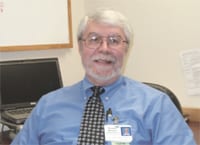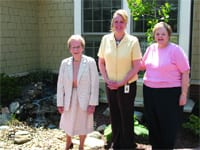Back to Health CDH Program Treats Back Pain and Helps Patients Keep It Away
Stephen Murphy calls it “a quiet epidemic.”
He’s talking about back pain — something that 80{06cf2b9696b159f874511d23dbc893eb1ac83014175ed30550cfff22781411e5} of Americans struggle with at some point in their lives. Yet Murphy, director of Rehabilitation Services at Cooley Dickinson Hospital, says its causes and treatment remain misunderstood to a large swath of those people.
Back pain is the second-most-common reason for visits to primary-care doctors, and these problems often develop suddenly. According to the National Institutes of Health, acute or short-term low back pain can last from a few days to a few weeks.
Most acute back pain is the result of trauma to the lower back, which may be caused by a sports or work injury or a sudden jolt such as a car accident. Symptoms may range from muscle aches to shooting or stabbing pain, limited flexibility and range of motion, or an inability to stand straight. Chronic back pain, on the other hand, persists for more than three months and may develop naturally with age, obesity, arthritis, and other factors.
“It’s a combination of things,” Murphy said, “but one thing I find people doing is, they’re trying to be more active, but many of us have sedentary occupations and frequently overdo it with weekend work, whether it’s gardening, going for a long bike ride, or any number of things.”
“You can be in reasonably good shape and still have some aches and pains after doing that sort of thing. But if you have a little wear and tear, which is what arthritis is, those joints and muscles don’t respond as well as they did when you were 17 years old. People who have problems with discs, or arthritic changes, or aren’t in such great shape, those people can react much more negatively and have greater exacerbation.”
The good news, he said, is that most of these issues are amenable to treatment measures such as physical therapy.
“When people experience back pain, they may think surgery or injections are the typical course of treatment,” Murphy said. “Although sometimes those procedures are necessary, a more conservative approach is always the first option. The vast majority of people, young and old alike, respond to physical therapy methods.
“A lot of things can be addressed with specific changes, whether it’s posture or building up muscles,” he added, noting that many people, as one example, embark on exercise programs they aren’t ready for. “Someone will buy a DVD from an infomercial on television about strengthening their core … we get a fair amount of business through that.”
By ‘we,’ he’s referring to the comprehensive Rehabilitation Services program at Cooley Dickinson, which has five locations throughout Hampshire County — in Hadley, Easthampton, South Deerfield, Worthington, and at the hospital itself in Northampton. Murphy says he wants to raise the profile of CDH’s services aimed at treating and (just as importantly) preventing back pain.
“We help people with injury prevention and also see people who need to be treated right away for acute pain,” he said, adding that services are available for all ages. “We want to help them get over the pain but also prevent the injury from occurring again.”
Back to Basics
Murphy, a practicing physical therapist and exercise physiologist specializing in treating spine pain, says people should not have to live with back pain.
“The therapists at CDH will assess the patient’s pain, do a thorough evaluation, and customize an approach to speed recovery from back pain, all in collaboration with the referring physician,” he said. “The therapist’s role is to identify how we can address someone’s symptoms, whether it’s low back pain or neck pain or something else, and get them back functioning safely at a high level.”
Many problems are exacerbated simply by growing older, Murphy said, and the CDH clinics can, in many cases, provide professional advice on stretching, conditioning, and proper body mechanics to help patients prevent back pain, in addition to conducting physical therapy when symptoms arise.
“Health care has changed over the past decade,” he noted. “It’s not just about trying to put the proverbial bandage on, but really looking at preventing pain and keeping people healthy in the long term so they can continue to stay active.”
Staying active is particularly a refrain for the Baby Boom generation, now starting to enter its retirement years. From arthritis to osteoporotic fractures, this group needs to understand the importance of preventing pain before it starts.
“They’ve saved for retirement, and they want to enjoy retirement,” Murphy said. “Especially in this community, in Western Mass., it’s a really health-conscious region. A lot of people are hiking all over the place, and you don’t have to drive far to find someone with a kayak on their roof, or going to one of the local rollerskating or rollerblading rinks. I did that recently, and I wasn’t the oldest person on the rink, which was kind of neat.”
In short, the goal of his program is to “get people back and functioning at a high level — back on the golf course, biking, back home gardening, whatever it is.”
Murphy’s, many of whom have doctorates or advanced certifications in physical therapy, are trained to deal with many common and uncommon conditions such as arthritis of the spine, disc derangements, and osteoporosis of the spine. Physical therapists, he explained, are experts in evaluating and analyzing movement and function.
Some of the approaches they use for evaluating and treating patients — with names like McKenzie, Maitland, Paris, and Norwegian — are used internationally, he added. “My therapists have been trained in these systems from all over the world.”
Ounce of Prevention
Most people experiencing sudden pain in their back or elsewhere, Murphy said, don’t wait too long before seeking help.
“It’s unusual for someone to ignore really severe problems — like if someone wakes up after a weekend of work, and all the way down their leg and part of their foot is numb, or they’ve lost strength in the foot or ankle. Obviously, that’s a problem that needs to be addressed by a physician right away. It’s unlikely that most people would ignore these symptoms.”
But he stressed, again, the importance of keeping pain and injuries away to begin with.
“It’s important, as a community hospital, that we put our emphasis on keeping people in the community as healthy as possible and keep them out of the hospital,” he said.
That focus on preventative care extends to educational outreaches Murphy and his team offer through regular public seminars on all sorts of therapy-related issues. “These talks are open to anyone, and there is no charge. I’ll come out and give them to five or 50 people, and I try to do them weekly.
“These talks explain basic bioanatomy, basic body mechanics, and the kinds of conditions you can get,” Murphy continued. “For example, I’ll explain what disc problems are and what arthritis is, and then give some generic information on basic exercises, common-sense approaches, and minimizing your risk of having injuries, and what to do if you do, in fact, experience some symptoms.”
As that 80{06cf2b9696b159f874511d23dbc893eb1ac83014175ed30550cfff22781411e5} statistic shows, plenty of people will occasionally wake up to pain. But they shouldn’t have to keep quiet about it.



Comments are closed.